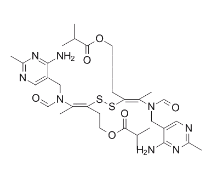All AbMole products are for research use only, cannot be used for human consumption.

Sulbutiamine shows neuroprotective effects on hippocampal CA1 pyramidal neurons subjected to oxygen-glucose deprivation. Sulbutiamine enhances electrophysiological properties such as excitatory synaptic transmissions and intrinsic neuronal membrane input resistance in a concentration-dependent manner. Sulbutiamine attenuates apoptotic cell death induced by serum deprivation and stimulates GSH and GST activity in a dose dependent manner. Furthermore, sulbutiamine decreases the expression of cleaved caspase-3 and AIF.
| Cell Experiment | |
|---|---|
| Cell lines | neuroblastoma cells |
| Preparation method | Cell viability of hippocampal slices subjected to OGD with or without sulbutiamine was determined by TO-PRO-3 iodide staining (dilution 1 : 1000). |
| Concentrations | 1, 10 and 50 μM |
| Incubation time | 15 min |
| Animal Experiment | |
|---|---|
| Animal models | Rats |
| Formulation | Arabic gum, 15% w/v |
| Dosages | 12.5 mg/kg |
| Administration | i.p. |
| Molecular Weight | 702.89 |
| Formula | C32H46N8O6S2 |
| CAS Number | 3286-46-2 |
| Solubility (25°C) | 75 mg/mL in DMSO |
| Storage |
Powder -20°C 3 years ; 4°C 2 years In solvent -80°C 6 months ; -20°C 1 month |
| Related Products |
|---|
| 7-Deoxyloganin
7-Deoxyloganin is a biosynthetic precursor of Loganin. 7-Deoxyloganin undergoes hydroxylation catalyzed by 7-deoxyloganin 7-hydroxylase, a cytochrome P450-dependent monooxygenase, to produce Loganin. |
| Mannose-BSA
Mannose-BSA is an important organic intermediate that combines the properties of mannose and bovine serum albumin, which is of unique value in the field of scientific research, and can be used as a key substance in a variety of organic synthesis reactions. Mannose is an important monosaccharide that binds specifically to mannose receptors (e.g., CD206 receptors on dendritic cells and macrophages), and therefore has a wide range of applications in immunomodulation and targeted drug delivery. BSA is a protein carrier that is commonly used for biocoupling, and its abundant surface amino groups can covalently bind to mannose to form a mannose-BSA complex. |
| Sulfo-NHS-Biotin
Sulfo-NHS-Biotin stongly label single SDS-2ME soluble cuticular protein. |
| GAPDH-IN-1
GAPDH-IN-1 (GAPDH Inhibitor Compound F8) is a covalent inhibitor of GAPDH (IC50 = 39.31 µM). It viability of, and glucose metabolism in, HEK293 cells in a concentration-dependent manner. |
| O-acetylcamptothecin
O-acetylcamptothecin is a derivative of camptothecin, a naturally occurring alkaloid extracted from the bark of the Chinese tree Camptotheca acuminata. Camptothecin and its derivatives are primarily known for their potent anticancer properties, particularly through their action as inhibitors of topoisomerase I, an enzyme critical for DNA replication and transcription. |
All AbMole products are for research use only, cannot be used for human consumption or veterinary use. We do not provide products or services to individuals. Please comply with the intended use and do not use AbMole products for any other purpose.


Products are for research use only. Not for human use. We do not sell to patients.
© Copyright 2010-2024 AbMole BioScience. All Rights Reserved.
